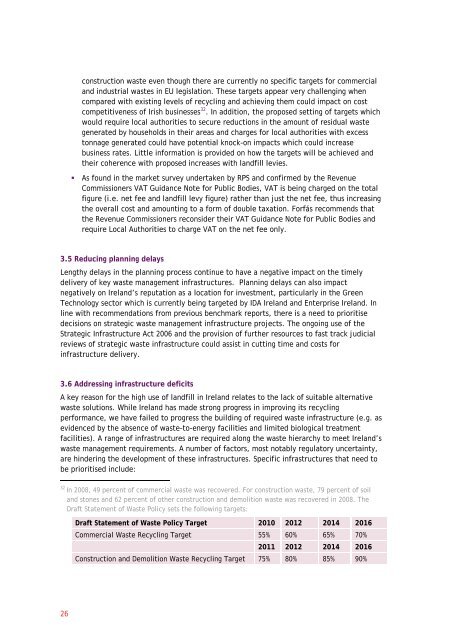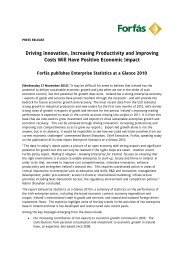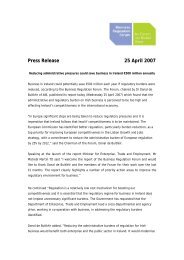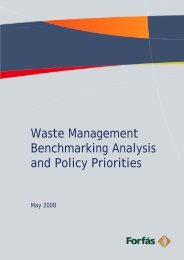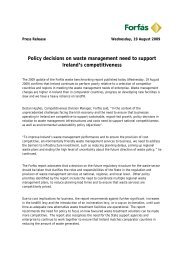Waste Management in Ireland: Benchmarking Analysis and ... - Forfás
Waste Management in Ireland: Benchmarking Analysis and ... - Forfás
Waste Management in Ireland: Benchmarking Analysis and ... - Forfás
Create successful ePaper yourself
Turn your PDF publications into a flip-book with our unique Google optimized e-Paper software.
26<br />
construction waste even though there are currently no specific targets for commercial<br />
<strong>and</strong> <strong>in</strong>dustrial wastes <strong>in</strong> EU legislation. These targets appear very challeng<strong>in</strong>g when<br />
compared with exist<strong>in</strong>g levels of recycl<strong>in</strong>g <strong>and</strong> achiev<strong>in</strong>g them could impact on cost<br />
competitiveness of Irish bus<strong>in</strong>esses 32 . In addition, the proposed sett<strong>in</strong>g of targets which<br />
would require local authorities to secure reductions <strong>in</strong> the amount of residual waste<br />
generated by households <strong>in</strong> their areas <strong>and</strong> charges for local authorities with excess<br />
tonnage generated could have potential knock-on impacts which could <strong>in</strong>crease<br />
bus<strong>in</strong>ess rates. Little <strong>in</strong>formation is provided on how the targets will be achieved <strong>and</strong><br />
their coherence with proposed <strong>in</strong>creases with l<strong>and</strong>fill levies.<br />
As found <strong>in</strong> the market survey undertaken by RPS <strong>and</strong> confirmed by the Revenue<br />
Commissioners VAT Guidance Note for Public Bodies, VAT is be<strong>in</strong>g charged on the total<br />
figure (i.e. net fee <strong>and</strong> l<strong>and</strong>fill levy figure) rather than just the net fee, thus <strong>in</strong>creas<strong>in</strong>g<br />
the overall cost <strong>and</strong> amount<strong>in</strong>g to a form of double taxation. <strong>Forfás</strong> recommends that<br />
the Revenue Commissioners reconsider their VAT Guidance Note for Public Bodies <strong>and</strong><br />
require Local Authorities to charge VAT on the net fee only.<br />
3.5 Reduc<strong>in</strong>g plann<strong>in</strong>g delays<br />
Lengthy delays <strong>in</strong> the plann<strong>in</strong>g process cont<strong>in</strong>ue to have a negative impact on the timely<br />
delivery of key waste management <strong>in</strong>frastructures. Plann<strong>in</strong>g delays can also impact<br />
negatively on <strong>Irel<strong>and</strong></strong>’s reputation as a location for <strong>in</strong>vestment, particularly <strong>in</strong> the Green<br />
Technology sector which is currently be<strong>in</strong>g targeted by IDA <strong>Irel<strong>and</strong></strong> <strong>and</strong> Enterprise <strong>Irel<strong>and</strong></strong>. In<br />
l<strong>in</strong>e with recommendations from previous benchmark reports, there is a need to prioritise<br />
decisions on strategic waste management <strong>in</strong>frastructure projects. The ongo<strong>in</strong>g use of the<br />
Strategic Infrastructure Act 2006 <strong>and</strong> the provision of further resources to fast track judicial<br />
reviews of strategic waste <strong>in</strong>frastructure could assist <strong>in</strong> cutt<strong>in</strong>g time <strong>and</strong> costs for<br />
<strong>in</strong>frastructure delivery.<br />
3.6 Address<strong>in</strong>g <strong>in</strong>frastructure deficits<br />
A key reason for the high use of l<strong>and</strong>fill <strong>in</strong> <strong>Irel<strong>and</strong></strong> relates to the lack of suitable alternative<br />
waste solutions. While <strong>Irel<strong>and</strong></strong> has made strong progress <strong>in</strong> improv<strong>in</strong>g its recycl<strong>in</strong>g<br />
performance, we have failed to progress the build<strong>in</strong>g of required waste <strong>in</strong>frastructure (e.g. as<br />
evidenced by the absence of waste-to-energy facilities <strong>and</strong> limited biological treatment<br />
facilities). A range of <strong>in</strong>frastructures are required along the waste hierarchy to meet <strong>Irel<strong>and</strong></strong>’s<br />
waste management requirements. A number of factors, most notably regulatory uncerta<strong>in</strong>ty,<br />
are h<strong>in</strong>der<strong>in</strong>g the development of these <strong>in</strong>frastructures. Specific <strong>in</strong>frastructures that need to<br />
be prioritised <strong>in</strong>clude:<br />
32 In 2008, 49 percent of commercial waste was recovered. For construction waste, 79 percent of soil<br />
<strong>and</strong> stones <strong>and</strong> 62 percent of other construction <strong>and</strong> demolition waste was recovered <strong>in</strong> 2008. The<br />
Draft Statement of <strong>Waste</strong> Policy sets the follow<strong>in</strong>g targets:<br />
Draft Statement of <strong>Waste</strong> Policy Target 2010 2012 2014 2016<br />
Commercial <strong>Waste</strong> Recycl<strong>in</strong>g Target 55% 60% 65% 70%<br />
2011 2012 2014 2016<br />
Construction <strong>and</strong> Demolition <strong>Waste</strong> Recycl<strong>in</strong>g Target 75% 80% 85% 90%


